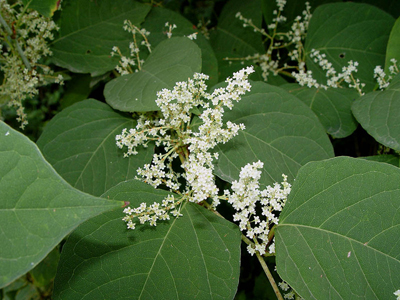Japanese Knotweed, the Unwanted
Watch out for Japanese knotweed near waterways!
So what is this plant, at the bend of the path masking the river with its large pointed leaves? Japanese knotweed (Fallopia japonica or F. sachalinensis) is out of place at the edge of our waterways. Native to the Himalayas, it was introduced a few decades ago as an ornamental plant. It was not long before it replaced the local vegetation and earned its name as an invasive or nuisance plant.
For those who do not recognize it, simply look for a shrub with broad leaves, pointed at the end. These leaves are supported by reddish and hollow stems 1-2 cm wide, similar to bamboo shoots. This nuisance is still not well known by the public.

However, it represents a real threat to the stability of the ecosystems that are our rivers. Its ability to establish itself on poor and shaded soils has enabled it to colonize the banks of rivers eroded by floods or at the edges of roads and unmaintained embankments. It might sound like a good thing, but once established this plant takes over and prevents all other species from growing, thus depleting the biological diversity of the habitat.
Another problem is the access to the watercourse, made impassable by a green wall, as well as soil erosion during the cold season, since this plant spends the winter dormant. It also has a very limited root system compared to its large aerial system.
What can we do ? It is unfortunately unimagineable at the present to hope to eliminate this plant wherever it has taken over. Its very rapid growth, the toxins secreted at its roots to prevent the development of other plants, or its ability to reproduce from a simple fragment of a stem or root, make it a formidably efficient plant.
Direct treatments, which consist in regularly cutting the young shoots as soon as they reach 50 centimeters in height, then the regrowths as soon as they reach the same size – that is to say 3 to 4 times a year – are not easy to implement. Especially since the regrowth can still appear 10 years after the first cut. The use of herbicides or other chemical processes is delicate around watercourses and leads to degradation of the environment, as well as the disappearance of all the plants present, including those which are beneficial.
It is possible however, to limit the expansion of Japanese knotweed to sites already affected by monitoring new spots or areas, and pruning them regularly. It is also essential NOT to plant knotweed near water courses, as it will soon replace the existing vegetation.
Whether after cutting, or to prevent establishment of knotweed on bare soil, the best preventive action is to plant trees (willows, ash, alder) with grasses between them so that they compete with the invasive species for light and soil as much as possible.
Let’s act together to prevent this plant taking over our biodiversity!